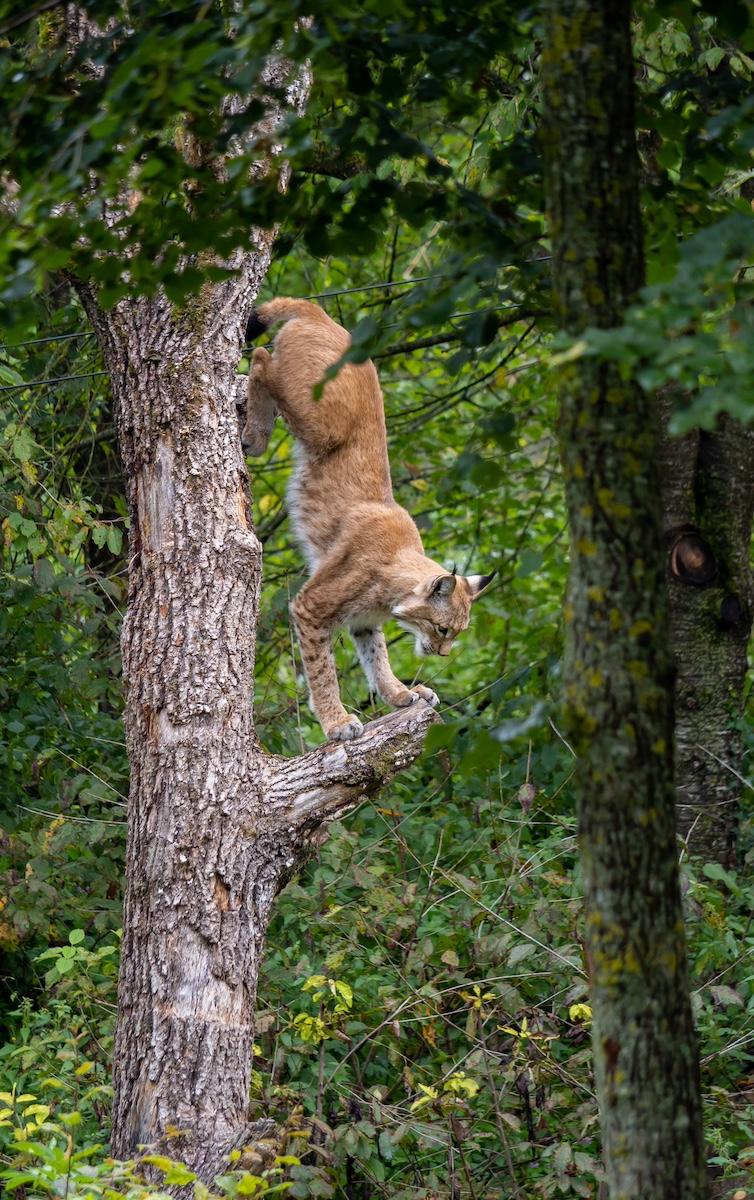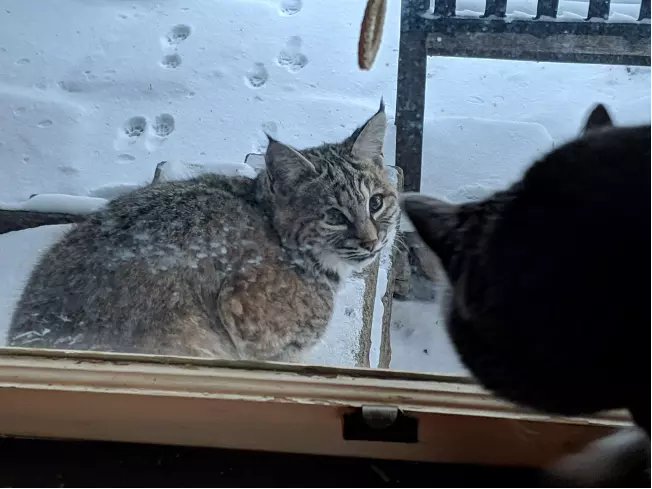End Hounding
Trophy Hunting Methods
Using Hounds and High-tech gadgetry
Trophy hunts start with dog packs — up to eight — fitted with GPS radio collars that flush out a mountain lion, chase the animal through the forest, and contain the cat up a tree. The outfitter and /or trophy hunter finds the location with a handheld directional antenna, and shoots using a rifle, handgun, muzzle-loader, smooth-bore musket, shotguns or bow.


Electronic caller product features:
10 mountain lion hunting calls
• Mountain Lion Whistle
• Mountain Lion Hiss
• Mountain Lions Courting
• Mountain Lion Growls
• Angry Mountain Lion
• Mountain Lion Roars
• Fawn Distress
• Jackrabbit Distress
• Rabbit Distress
Baiting
Colorado allows Electronic Calls to lure in mountain lions. E-Calls are recorded sounds of distressed prey. Trophy hunters say it works.
“This is not a hunt. All the high tech gadgetry, the GPS collars with dogs doing all the work while the ‘hunter’ sits in his truck drinking coffee until the cat is treed … you might as well call the dogs off and go home because this is not a hunt.”
research biologist with Arizona Game and Fish Department, retired
Author of Soul among Lions: The Cougar as Peaceful Adversary

“Like many of my friends and neighbors who hunt for food on the table, I only shoot what I want to eat. This is why I would never hunt a Colorado mountain lion or trap a Colorado bobcat (or lynx).”

A Conscientious Hunter's View on Trophy Hunting
By Brett Ochs, Colorado hunter and CATs member
I'm an avid hunter and outdoorsman for 30-plus years and a native Coloradan. Like many of my friends and neighbors who hunt for food on the table, I only shoot what I want to eat. This is why I would never hunt a Colorado mountain lion or trap a Colorado bobcat (or lynx).
What is the value of a bobcat? A few years ago, an analysis by Lisa Robertson of Wyoming Untrapped and Mark Elbroch of the cat conservation group, Panthera, was published in the journal Biodiversity and Conservation. Based on the amount of money spent by a large number of wildlife photographers who traveled to Yellowstone to see this bobcat along the Madison River, its short-term economic value was – brace yourself – more than $308,000 for the regional economy over just a winter season.
That’s a value 1,000 times greater than the potential value of $315 (when fur was valued higher, now maybe $30) a trapper would net for a bobcat pelt ultimately destined to line a hat or coat. “Also consider," the authors wrote, "that this same living bobcat could generate the same figure again the following year, should it survive the summer season in Yellowstone." Elbroch and Robertson acknowledged that a bobcat outside national parks (trapping is not allowed in national parks) would likely return less economic value as a focal point of wildlife watchers. “But over its life, this bobcat in Yellowstone alone could [theoretically] generate well over $1 million in economic activity, shared across countless people involved in travel and tourism.” And that sum doesn't include the value if it helped produce offspring.
(continued, use cursor for dropdown)
At present, a furbearer hunter in Colorado can purchase an annual license for about $33.95 and kill as many bobcats (and Badger, Mink, Pine Marten, Gray Fox, Red Fox Swift Fox, Raccoon, Ring-Tailed Cat, Striped Skunk, Western Spotted Skunk, Long-Tailed Weasel, Short-Tailed Weasel, Opossum, Muskrat, Coyote, and Beaver). Yes, you read that right, and some are year-round and without limit-this is deplorable. Then there is the very clear fact of the ecological value of bobcats in Colorado as part of a full and intact native predator and prey ecosystem.
You may be surprised that a hunter says this. Not all “hunters” are what you see and hear from the media, magazines, and TV shows.
CPW lightly mentions habitat improvements but heavily weighs on the “control” of predators. Predators have a role in the ecosystem and have an intrinsic contribution to controlling deer populations. CPW needs to change the main focus of this strategy for increasing populations towards repairing the habitat for mule deer.
The thing that most citizens don’t know, is who is sitting on this Wildlife Commission board within CPW, these people make the final decisions. To start out a person can only get on this board by executive order by the governor, not by a vote; this policy needs to be abolished! There obviously is a huge conflict of interest, when decision-makers are from special interest groups and don’t want to be accountable to environmental concerns that get in their way of making money.
Brett has been hunting the majority of his life and believes that mountain lions belong on the natural landscape and should not be hunted for sport. He is outspoken on the need for more ethical hunters in Colorado to not be afraid to speak up for the true conservation of carnivores.
You can listen to Brett speak here: Wolfwatcher – Take a listen: Brett Ochs details the perspective of a hunter who is a pro-wolf advocate.
In an effort to help the non-hunters better understand "sportsmanlike" behavior.
(continued, use cursor for dropdown)
- Speak up against proposals like continued Trophy hunting/trapping using any means possible. The humans who agree with those statements are not hunters, they are shooters.
- Know, understand, identify, and respect the animals and the habitat they live in.
- Give fair chase for the animal you are pursuing. (You have a HUGE advantage with a rifle.)
- Use no baiting, spotlighting, dogs, smells, or other various methods of “attracting” animals.
- No shooting of young offspring, pregnant mothers, or taking more than you can use.
- When you do harvest an animal, give it the respect that it deserves by honoring it and all that it is providing you. This also means using all parts of this animal and not just the parts that feed the ego, i.e. antlers.
- Appreciate the carnivores that need this same animal to survive. Take a stand against anyone who believes we are better without carnivores. Big picture, folks!
- Walk, sit, scan, breathe, and feel the landscape. Get up early walk in the night (without headlamps), watch the sunrise, and shiver, so that you appreciate what it takes to survive without the comforts we have.
- Be grateful for the opportunity and privilege you have.
hounding IS THRILL-KILLING FOR TROPHIES AND PERSONAL PROFIT
While outfitters and guides advertise an unsporting, guaranteed kill without shame, and testimonials show they make the sport a shooting gallery, not a hunt
(to pause on the carousel, hover over the quote)
"Did u get a rush from it, the rush is the best part."
From a mountain lion hunter's facebook post
A mountain lion hunter tells his story on Colorado sports radio.
"I was all jacked up, because hunting a mountain lion is like Christmas morning for me."
"What kind of success rate do your clients see?
100% Success ... most of your travel will be on an atv or utv ... You have a great chance at a book (record Trophy) Lion."
From the FAQ website of a Colorado mountain lion outfitter
"We try to get as close to were (sic) the mountain lion is treed on a ATV if possible. We have use of ATV's, snowmobiles, trucks, and if we need horses and mules!"
A Colorado outfitter explains what explaining their $8,000 trophy hunt includes
“We pride ourselves on being able to catch and produce (sic) lion in all conditions…. There is nothing better than walking into a big tom lion bayed on a cliff surrounded by some of the hardest working dogs a man could ask for.”
"Mountain lion hunting means hunting with dogs. Trained dogs are used to track down and trap a cougar. Bowhunting an angry lion is a serious challenge when its cornered 30 feet up in a tree. It’s cats vs. dogs in this heart-pounding hunt video."
Eastman’s blog archive
Testimonial from a mountain lion trophy hunter on a Colorado outfitter site
"This was defiantly (sic) an experience of a lifetime … getting me a trophy Tom."
Testimonial from a mountain lion trophy hunter on a From a client of a wild cat outfitter
"Driving roads after a fresh snow is probably the most common method of locating a lion track. This can be accomplished with pickups, ATVs, or snowmobiles. It allows you to cover a lot of country and not tire yourself, or your dogs."
Western Hunter Magazine
"When you get to your hunting area, pull your vehicle off to the side of the road, and when you get out, be sure you don't slam the doors, don't talk to one another, and don't smoke,".... You want to get 60 to 100 yards away from your vehicle … When you begin calling, don't let your enthusiasm destroy the reality of the drama you're attempting to create.… a bobcat may take 30 minutes or more…. Arguably, no form of hunting is more demanding of skill, dedication, shooting ability and patience than bobcat calling.… Miss him the first time, and you can call him back again and again."
See our science page for the top 10 science-backed reasons not to trophy hunt and trap Colorado’s wild cats.

